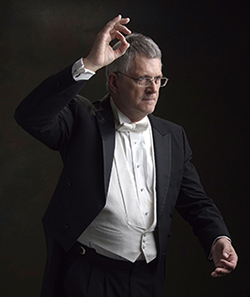By Cheryl Conner – Forbes Contributor
In my recent article on Cooperative Capitalism I promised more information from CEO Space faculty co-lead Hugh Ballou, who directs that effort together with multi-award winning author and expert on integrity in business Dr. David Gruder. The two coach, train and provide keynote addresses and learning experiences for corporations, both individually and jointly.
Of particular interest to me was seeing the way Ballou’s years of background as a music conductor have contributed to the skills he presents to leaders of organizations of all sizes including the world’s largest musical efforts, church organizations and even Fortune 1000 CEOs.
Says Ballou: “In 40 years of music ministry I conducted my work with my back to the audience.” Now, in his leadership training, he is addressing the challenges corporate leaders face head on.
Ballou defines a leader as one of three things:
- A person who gets things done.
- A person who learns how things get done.
- A person who accomplishes work by influencing others.
Sometimes the influence is autocratic and negative. In other cases it’s based on inspiration, through trusted relationships (which is the path he selects and promotes).
Orchestrating Success
Have you ever watched a musical conductor at work? It’s leadership in motion. There is never an instant of indecision or a moment of doubt. The musical conductor is always in control. This may sound and seem like a dictatorship, but it is not, Ballou says. Nor is it a democracy, as a single person directs the will of others and the artistic vision that will shape the result.
On a corporate team, the leader articulates a vision through carefully crafted goals and empowers and directs key players in their role to the outcome and success.
In either case, the leader inspires the maximum result by inspiring and empowering the team of participants. If the leader is open and straightforward, the team will engage and do their best to succeed. But if the leader is ill-prepared, guarded and uncommunicative…the result is subpar (or perhaps a disaster).
Each player is highly skilled, and each person contributes the best of their unique talent. Together, the team creates a result that far surpasses what any individual could produce on their own. If the leader tells an expert oboe player how to play oboe – by the next season that player will likely be gone. But if he or she can bring out the greatest creativity and enthusiasm in the player, magic ensues.

Today, leadership coach Hugh Ballou trains leaders ranging from startup entrepreneurs to Fortune 1000 CEOs
From a musical conductor we can observe the following, Ballou says:
- If the leader is autocratic, there’s a limit to success.
- The leader should strive to portray a commanding presence—not a fearful dominance.
- The leader is only as effective as his or her success in inspiring and leading others.
- The leader defines how the result is expressed:
- With passion and commitment
- With unanimity of movement and expression
- With a combination of skills that create momentum
- With unity of pace and harmony
- The leader invites people to participate through the aura of their presence
- The leader knows and communicates that the team can only achieve its result with every member doing their best
Conductors and leaders inspire the highest possible performance from the groups that they lead. They are alert to circumstances and make adjustments and changes needed as the program progresses to ensure an optimal result. According to Ballou, corporate leaders can do much to sharpen their skills and understanding of ideal leadership by attending a symphony performance and observing the nuances and non-verbal signals that separate the merely good and acceptable from inspiring and unforgettable.
From Music Conductor to Meeting Conductor
One of the great problems Ballou notes that leaders seem to universally face is that they want to blame others for the problems they helped to create. Perhaps they are unclear about specifics or time frames and fail to provide mentoring. Sometimes as leaders we confuse mentoring with micromanaging, Ballou says. When leaders fall short, he suggests they turn around once again, to take a close look in the mirror.
As Ballou teaches leaders he often uses his orchestra experience as an analogy:
- The orchestra lecturn holds the score (the strategic plan.)
- Every event that will happen is notated, with clearly defined roles and parts.
- The action plan is directly tied to the musical score.
- The CEO directs from the score (as opposed to playing the music). Their highest value is inspiring and allowing other people to perform to their highest level of expertise.
- As a conductor, the team lead (or CEO) begins with the “why” of a given performance, influences people with a common purpose, then gives them a clear pathway and coaches them to excellence.
- The choir or orchestra’s job is to listen to each other, and to use their level of expertise and also combine it with others then to attain a harmonic ensemble result. Many leaders inadvertently squelch these possibilities by being the “answer person” rather than allowing people to function in the areas they know best (a phenomenon leadership expert Murray Bowen has described as “irresponsible responsibility”). The result: A burned out leader and a frustrated team.
“In audiences and in facilitations it’s been interesting to note that 65-75% of those who attend have had some musical experience, and the rest have generally observed a conductor,” Ballou says. “So when I create the analogy, I hear ‘Ah’.”
“I particularly enjoy working with startup entrepreneurs,” says Ballou. “In these cases, companies can create a ‘ground up’ culture of high performance.”
That culture is vital, he notes, in that the U.S. currently suffers from an estimated 70% disengaged employees, according to research numbers from Gallup. It is an epidemic that costs organizations millions of lost hours and billions in lost revenue, particularly when we consider the vast hours leaders spend undoing conflict, much of which they’ve inadvertently (or occasionally even purposely) set up as a misguided ploy to show strength.
Relationships, trust, and a sense of ensemble are vital for optimal companies and teams, Ballou says.
“I love the concept of Jazz ensembles as an analogy,” he says. “It’s the most creative musical form we have in America. But it is not at all haphazard. In a group you have a chord structure, a rhythm, and there are rules of the road to dictate behavior such as if you don’t have a solo, you don’t play loud.”
“Yet we have leaders declaring, ‘I don’t want to be held back by a plan’. With a good structure, you have the room to be creative. Leaders tell me ‘I don’t have time to write down my goals.’ So do you have time to redo your projects, I ask?”
Finally, Ballou shares a set of leadership principles that music conductors know best:
- Know the score. Know your vision and plan, and set it down in advance.
- If you want a good ensemble, hire the best players. Look for good skills and good potential to grow.
- Build effective relationships. Leaders lead people; managers manage money.
- Every fine ensemble rehearses for every performance. But we often run straight to execution in business and then we execute poorly. By doing so, we build the DNA for poor performance. If we don’t rehearse what we want to accomplish as leaders, we’re modeling poor leadership (which others will copy). Is this the legacy we want to instill?
- Prepare for meetings by preparing for the outcomes. Within meetings, allow people to play their instruments and to do their parts.
- Value the rests. The pauses in any musical score are there for a distinct reason. They are punctuation. Yet as leaders we don’t value rest and we don’t put it into our calendar. We need time to plan, evaluate, think, rest and play. In doing this, we deprive ourselves of the chance to perform as a whole person, so we don’t show up as our best selves. An anxious leader communicates anxiety that is contagious throughout the whole human system. So we should value the rest periods and we should perpetually work on ourselves.
Ballou calls his program Transformational Leadership. To find additional resources or to visit with Ballou directly, readers can visit his blog atwww.transformationalstrategist.com or his personal website atwww.synervision.us.


